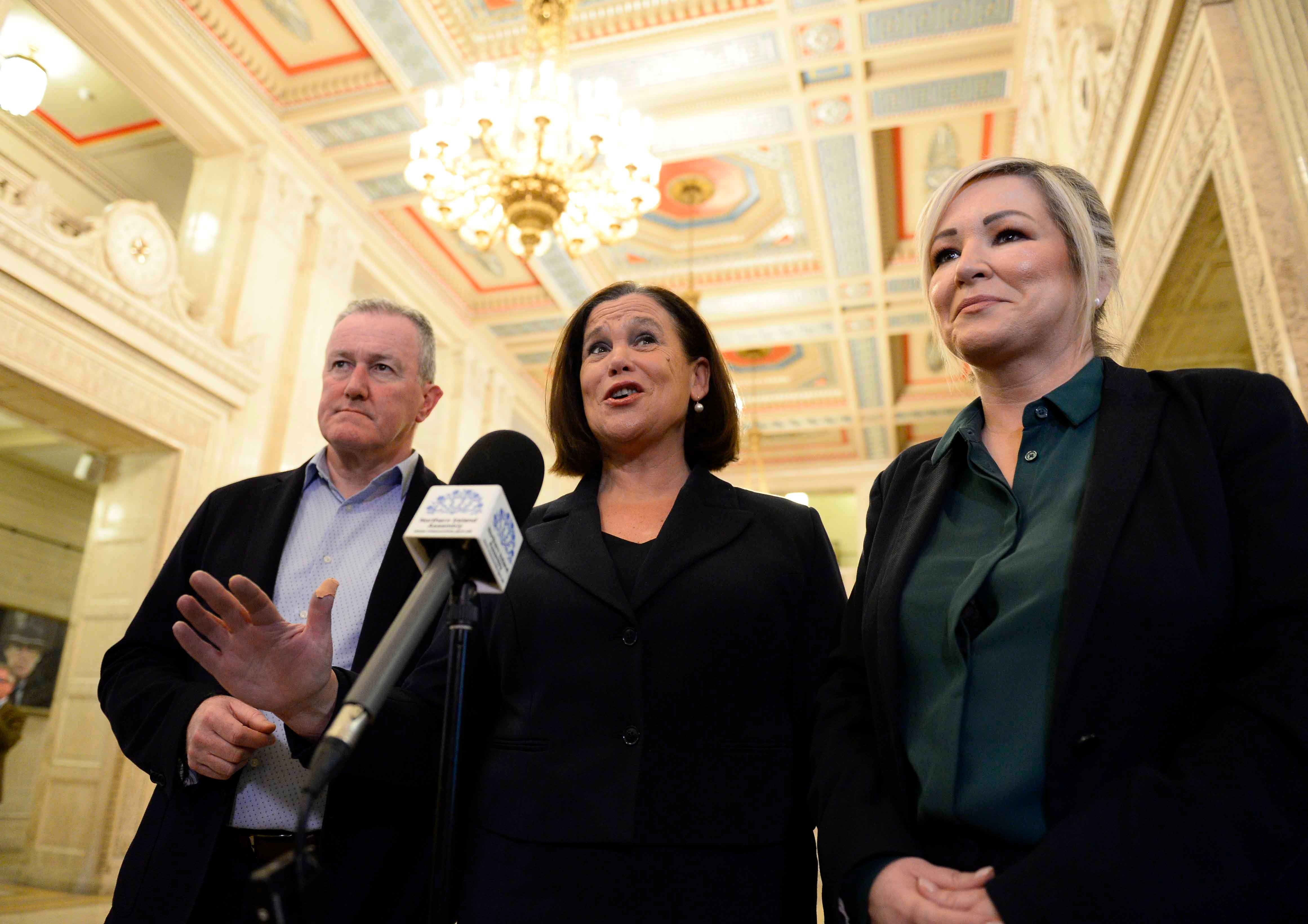What does the restoration of power-sharing mean for Northern Ireland?
With Sinn Fein only increasing in popularity and the shuttered Belfast government looking set to reconvene, the politics of Northern Ireland is transforming before our eyes. Though talk of a united Ireland may be a bridge too far, the effects are far-reaching and vital to understand, writes Sean O’Grady


With fresh legislation to restore power-sharing to Northern Ireland being rushed through parliament with little resistance, a new government at Stormont could be formed by next week. It will, for the first time in the history of the province, be headed – at least symbolically – by someone who is an Irish republican, Michelle O’Neill, the vice president of Sinn Fein. It is another fascinating and perhaps portentous pact of recent historic developments. Just for a second, there appear to be grounds for optimism...
Does this mean that Sinn Fein now run Northern Ireland?
No – because of power-sharing no one community or political party can ever boss the others, and the principle of consent is central to the delicate machinery set up in the Belfast Good Friday Agreement back in 1998. The Unionists retain a veto, and the deputy first minister, presumably Sir Jeffrey Donaldson, will in effect be a co-first minister. Northern Ireland is thus unusual in the world in being a “duarchy” with the ultimate executive power shared by two figures with equal power, as well as a wide variety of parties being given ministerial roles – the Ulster Unionists, Alliance Party and Irish nationalist SDLP will also fill the government jobs. It’s rather like a government made up of a Tory premier, Labour deputy and with Lib Dems, SNP, Plaid and Greens all in the cabinet.
So why is this such a big deal for Sinn Fein?
It’s a big deal because of the symbolism and prestige attached, however spurious in reality, to that title of “first minister”. Ironically, when the Unionist parties were always expected to be the largest single grouping and would thus supply the nominee for first minister, with the SDLP or Sinn Fein second and inevitably “deputy”, Sinn Fein suggested that the two roles be relabelled “co-first minister”. That idea never got very far, but, with hindsight it might have been better if the Unionists had indeed followed the SDLP’s advice.
In fact, this has been a long time coming, in the sense that Sinn Fein actually “won” the role because they became the largest party in the Northern Ireland Assembly back in the May 2022 elections, after the DUP lost substantial support to more hardline, Loyalist groups. So in effect, O’Neill has been first minister-designate for almost two years. The DUP had already boycotted the Assembly and Executive over their objections to the Brexit Northern Ireland Protocol by the time of the elections, but some say their determination to stay outside was strengthened by their symbolic demotion to second party in the province and having to make do with the deputy role – hard to accept after so long in the ascendancy.
South of the border, Sinn Fein has also been making progress and is now in the lead in the opinion polls, albeit sagging a little in recent months. At the moment they are the main opposition to the grand coalition formed by the historic but now denuded two main parties, Fianna Fail and Fine Gael, neither of which would want to form a coalition with Sinn Fein – quite a lot of history and ideological baggage stands in the way. Even so, if Sinn Fein got lucky they could find themselves in office and with a share in power north and south of the border on the island of Ireland. If that ever came to pass they would be able to boast at least a simulacrum of a unified 32-county Ireland.
Nonetheless, as her Republican critics argue, O’Neill and her colleagues will find themselves administering a province of the United Kingdom that was imposed through partition in 1922, and never accepted by Republicans, and of course, violently opposed by some. It does, incidentally, beg the question as to why, if O’Neill and her colleagues are willing to take part in a “British” administration in Belfast they still refuse to send their elected MPs to Westminster.
How big a disappointment is it for the Unionist community?
For democratic parties, losing an election, as the DUP did in 2022, is always a disappointment, but the poignancy is heightened by the fact that, if added together, the Unionist votes that go to the DUP, the older and more moderate Ulster Unionist Party (which used to dominate politics) and the Loyalist group Traditional Ulster Voice would be sufficient to secure the first minister role and form a more coherent Unionist force in the institutions. But they argue too much.
The fact is that the old Northern Ireland parliament, gerrymandered by its founders to be a “Protestant parliament for a Protestant people”, always yielded a Unionist premier and, because the party formed a bloc with Conservatives at Westminster, they were usually close to power in London too. Times have changed, but the biggest threat to the strength of the Union has been Brexit, which has imposed an economic barrier with Great Britain, yet kept a seamless invisible border with the south of Ireland. The excruciating irony is that the DUP instinctively campaigned for Brexit in the 2016 referendum and then supported Boris Johnson’s bogus “hard Brexit” posturing in 2019, only to be lumbered with the hated Northern Ireland Protocol. The DUP hasn’t been the most agile of political beasts in recent times. It is also always worth remembering that the DUP doesn’t by any means speak for all the people of Northern Ireland – which voted 56 per cent to 44 per cent to Remain in the EU in 2016.
Does it mean there will be a united or (for some) reunited Ireland?
No. There has been some shift in opinion in that direction since the Brexit referendum (uncomfortably so for the Leavers of the DUP), but most of the population of the province favours the status quo. If that did alter on a sustained clear basis, then a border poll would be inevitable; the Belfast Good Friday Agreement states that the British Secretary of State for Northern Ireland should call a referendum “if at any time it appears likely to him that a majority of those voting would express a wish that Northern Ireland should cease to be part of the United Kingdom and form part of a united Ireland."
A new factor in the debate about uniting Ireland is that the Republic has changed so much in recent times – no longer dominated by the Roman Catholic clergy (quite the reverse) and, despite the global financial crisis and near bankruptcy, Ireland is not one of the more prosperous corners of Europe – a reversal of the older norm of an industrial north outstripping an impoverished agricultural south. It is now at least arguable that the Northern Irish might be better off in Ireland and the EU – though the rest of the UK remains the primary source of trade.
Yet few people, by the way, seem readily convinced that the province’s unique position inside the UK internal market and the EU single market has given its people an economic boost.
How will Michelle and Sir Jeffrey get along?
Given the co-leadership nature of the first/deputy first minister roles and the constant quest for consensus under power-sharing, things work best if the duumvirate at the top is in harmony. Sometimes opposites, such as Jeffrey and Michelle, work well together. Martin McGuinness, ex-IRA terrorist and Ian Paisley, former trouble-making anti-Catholic bigot, enjoyed such a warm rapport they were known as “the chuckle brothers”. So unassailable was the strength of their respective credentials and political base that they managed to keep the show on the road for a time in the most unpropitious of circumstances. Later political marriages, such as that of McGuinness and Arlene Foster, were less chummy.
What could go wrong?
As ever, plenty. Rows about EU laws and border checks could flare up, despite the recent reforms, and the question of the status of the Irish language in the province remains unfinished business. As in Britain, but more so, there’s always scope for “culture wars”, often as not fuelled by historic grievances, parades, marches, bonfires, flags and religious divides – abortion rights being one such source of friction (and one where Westminster felt it had to impose its will, on the grounds that human rights are reserved to London). Low-level gangsterism and the underemployed terrorists who make a living from it, remain unsettling factors in the province.
Subscribe to Independent Premium to bookmark this article
Want to bookmark your favourite articles and stories to read or reference later? Start your Independent Premium subscription today.






Join our commenting forum
Join thought-provoking conversations, follow other Independent readers and see their replies
Comments